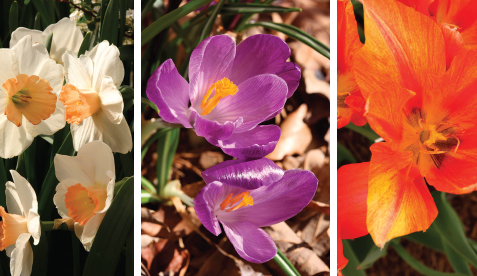It is prime planting time for such popular spring-flowering bulbs as daffodils, crocuses and tulips, and as any garden expert will tell you, adding essential nutrients to bulb beds now will help bring out the best from these beauties-to-be at bloom time.
Tops on the list for necessary bulb nutrients is phosphorus, which promotes strong root systems. Bone meal has been used by many gardeners as a source for phosphorus, but keep in mind that, because it is essentially crushed bone, spreading it in the garden could call out cats, dogs, raccoons and other critters to come digging around in search of a snack.
Potassium is another member of the famous N-P-K Gang, along with nitrogen and phosphorus, that is a key element for spring bulbs. However, a deficiency of this nutrient is rare because bulbs are very efficient at retaining an internal supply of this element. In addition, potassium is very slow to leach from the growing ground, so, except in the poorest of soils, some is usually available for bulbs when they need it.
On the other hand, nitrogen from a common source such as 8-8-8 or 10-10-10 fertilizer is not so steadfast in the soil. During rainy spells, it will last for little more than a month before it is leached away. This is not good, especially since studies have shown that nitrogen is actually as important to spring-flowering bulb plants as the all-mighty phosphorus. The main benefit of nitrogen for bulbs is that it encourages the growth of foliage — the botanical equivalent of solar cells that use the sun to help energize plant development.
Probably the best way to take care of bulbs’ requirements for nutrients at this time is with special time-release bulb fertilizers that only need to be added once at planting time. They s-l-o-w-l-y supply enough N-P-K for the winter and spring seasons, and most also contain a merry mix of vital trace elements that are necessary for proper bulb development. Scotts, Espoma and Holland are popular brands that can typically be found at garden shops, but there are others.
Also, incorporating compost into planting beds is an all-organic way to introduce additional traces of nitrogen, phosphorus and potassium as well as many other important elements into the garden. Well known as an outstanding soil conditioner, compost, through its natural chemical decomposition, will also add a slight N-P-K kick and supply small doses of key micronutrients such as zinc, copper, iron and manganese. In addition, since compost breaks down over time, it releases nutrients gradually into the soil, so there is never a problem of overdosing plants with this earthy fertilizer.
Spring-flowering bulbs are also sensitive to calcium deficiency and very acidic soils. If such conditions exist, foliage is likely to be small and pale in color. In addition, the stems will appear to collapse just about the time the flowers begin to open. That is if they open because, in extreme cases, the flower buds will form, but they won’t completely develop and bloom.
Luckily, both problems can be licked with the same medicine: calcium oxide — better known to gardeners as plain ol’ lime. Not only does it contain calcium, but it is also alkaline, which is just what is needed to get a planting bed out of a heavy acidic funk.
Lime does take its time becoming chemically incorporated into the soil — usually a couple of months — so an application now can do wonders for your bulbs’ springtime flower show to come.
L.A. Jackson is the former editor of Carolina Gardener magazine. If you would like to ask him a question about your garden, go to his website at: www.southeastgardening.com.







